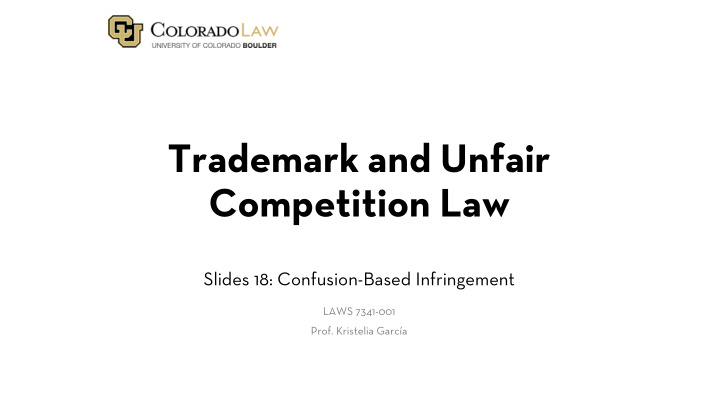



Trademark and Unfair Competition Law Slides 18: Confusion-Based Infringement LAWS 7341-001 Prof. Kristelia García
Class Outline • Likelihood of Confusion • Polaroid factors 2
To make a successful claim of trademark infringement, you must show both: 1. Use in commerce; and 2. “Likelihood of Confusion” 3
Likelihood of Confusion • Statutory bar to registration under § 2(d): • Cannot register a mark that so resembles a mark or trade name previously registered or used by another as to be likely when used on the goods of the applicant to cause confusion. • Statutory basis for federal suit for infringement of a registered mark under § 32: • Any person who shall use any reproduction or colorable imitation of a registered mark in connection with the sale of goods or services where such use is likely to cause confusion shall be liable in a civil action. • Statutory basis for federal suit for infringement of an unregistered mark under § 43(a) • Any person who uses any word, term, name symbol or device which is likely to confuse as to the affiliation, connection, or associate of such person with another person shall be liable in a civil action 4
Likelihood of Confusion Likelihood of Confusion generally arises in one of these two contexts: (I) administrative proceeding, or (II) infringement litigation I. Administrative Context A. Opposition to Registration B. Cancellation of Registration II. Infringement Litigation Context A. Based on Actual Use B. Via Declaratory Judgment 5
Polaroid Factors for Showing Likelihood of Confusion 1. Similarity of marks A. In Visual Appearance (spelling, graphics, trade dress) B. In Sound C. In Meaning 2. Similarity of goods and services A. Effect of corporate diversification, co-branding, lifestyle branding, etc. B. Effect of families of marks 3. The quality of the junior user’s product 6
Polaroid Factors for Showing Likelihood of Confusion (cont.) 4. Similarity of marketing and sales channels (Advertising, Facilities, etc.) 5. Sophistication of buyers and the care that they will take in making purchasing decision (how expensive are the goods?) 6. Strength and/or distinctiveness of the allegedly infringed mark (esp. “family of marks”) 7. Intent of alleged infringer (good/bad faith) 7
Polaroid Factors for Showing Likelihood of Confusion (con’t) These last two to be shown via presentation of direct evidence: 8. Evidence of Actual Confusion 9. Consumer surveys 8
Different factors, same idea: Second Circuit: “ Polaroid factors” Fourth Circuit: “ Pizzeria Uno factors” Ninth Circuit: “ Sleekcraft factors” 9
To make a successful claim of trademark infringement, you must show both: 1. Use in commerce; and ( ß Assumed) 1. Whether the plaintiff’s mark is entitled to protection; 2. “Likelihood of Confusion” 10
Polaroid Factors Relating to Likelihood of Confusion 1. Strength of the P’s mark 2. Similarity of marks 3. Proximity of products sold under P & D’s marks 4. Where products are different, likelihood that P will bridge the gap by selling products sold by Ds 5. Existence of actual confusion among consumers 6. Sophistication of consumers 11
Remaining Polaroid Factors 1. Bad faith 2. Quality of D’s products or services 12
Polaroid Factors, Ordered by Importance (Across all circuits; factors not listed appear to play no role in outcomes) 1. Similarity of the marks 2. Defendant’s intent (bad faith) 3. Proximity of the goods 4. Evidence of actual confusion 5. Strength of the plaintiff’s mark 13
Recommend
More recommend